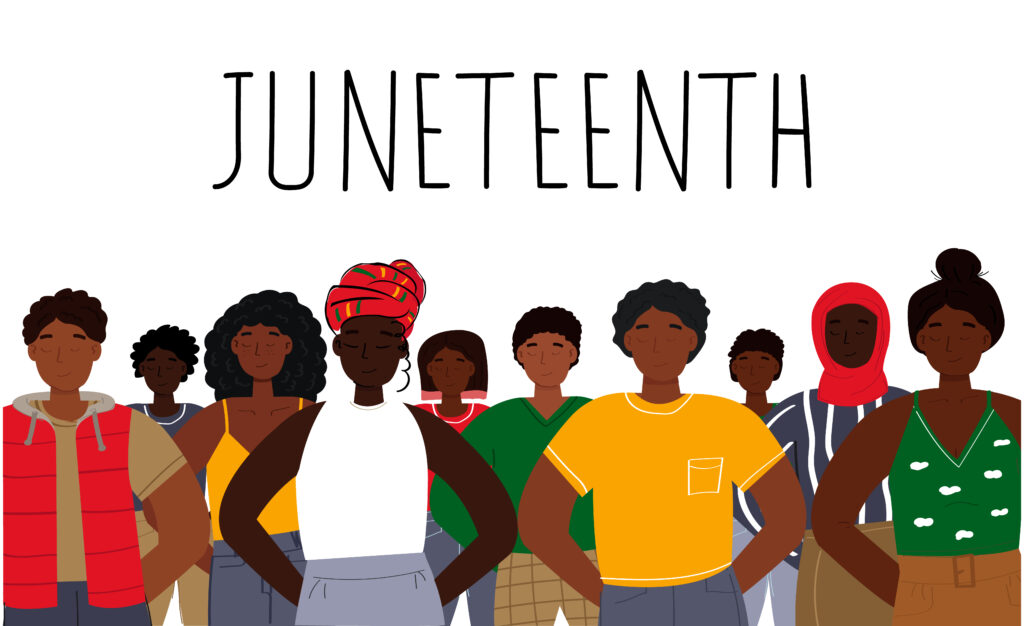Un-fair housing is an impediment to homeownership. Without fair access and opportunity to buy a home in this land of the free, homeownership likely feels to those denied like a nightmare, not the American dream. June is our annual reminder (not that we have necessarily forgotten) to advocate for homeownership for all.
Now, with federal recognition, Juneteenth is a remarkable reminder of an exercise toward the American dream of home and land ownership that we as real estate pros collectively can be proud to honor as advocates for homeownership during what is also National Homeownership Month.
It may be a coincidence that our National Homeownership Month and Juneteenth are connected, but we as real estate pros can be intentional about the commemoration and discussion of both. Case in point, check out this heartwarming story of homeowners learning that their new home was actually where their ancestors were enslaved — what a homecoming!
As you probably know, Juneteenth memorializes June 19, 1865, when the last of the American enslaved population (specifically in Texas) learned that slavery had become illegal. The formerly enslaved had a lawful opportunity for the first time to pursue the American dream of home and land ownership, the ultimate expression of American freedom.
What was happening at that time?
Savannah, Georgia’s Garrison Frazier and other prominent Black leaders (in talks with General Sherman in January 1865) emphasized that freedom for the enslaved was not simply the abolishment of barbarically forced labor but was also the opportunity to own land to “till … by our own labor,” according to Ira Berlin.
In essence, land and homeownership worked in tandem with and were fundamental elements of American freedom. Consequently, land and homeownership were typically denied to those enslaved despite the plethora of land grants the government gave to American citizens, like this example of 160 acres given to many at relatively no cost.
In other words, ironically, this was a period when the government was essentially begging citizens to care for the land in exchange for ownership rights.
The Savannah leaders’ sentiments were so impactful that General Sherman issued Special Field Order No. 15 that by June 1865, 40,000 formerly enslaved men had settled on 40-acre plots in the southeast — land that had been abandoned and scorched during the war — and had been given old Civil War mules.
Thus, Juneteenth also was a moment in history when the formerly enslaved in Georgia and South Carolina tasted the freedom of land ownership with their very own “40 acres and a mule.”
Real talk: It was truly a moment of a dream beginning to be realized despite 40 acres of untended land being only one-fourth of prior U.S. land grants, which were already customary for our government to confer to American citizens. Hence, this was not special treatment, but it was the beginning of something designed to look like fair treatment.
All’s well that ends well, right?
Key markers of un-fair housing beginning after the triumphs of Juneteenth
Infamously, by the end of that year, President Johnson had forcefully removed and redistributed those plots of 40 acres, evicting 40,000 dreamers. Thus, within weeks of Juneteenth, the American dream of land and homeownership was deferred for a significant chunk of American-born and raised residents — the formerly enslaved.
“What happens to a dream deferred?
Does it dry up like a raisin in the sun?
Or fester like a sore— And then run?
Does it stink like rotten meat?
Or crust and sugar over— like a syrupy sweet?
Maybe it just sags like a heavy load.
Or does it explode?” — Harlem, Langston Hughes, 1901-1967
Despite President Johnson’s efforts to veto civil rights, including fair housing, for the formerly enslaved, you may recall from pre-license courses there was actually a landmark Civil Rights Act of 1866 that, among other things, prohibited racial discrimination in real estate.
Thus, with the abolishment of slavery and the pronouncement of American citizenship with the 13th Amendment (1865), came the initial opportunity for some of the formerly enslaved to participate in the various land grants and other real estate deals as American citizens — the ultimate freedom. Those dream-making years have come to be known as the Reconstruction period.
However, “Black codes” that ignored the Civil Rights Act of 1866 began to crop up, which eventually led to “Jim Crow” ordinances that included the restricting and, in some cases, outright forced removal of Black and other people of color from home and land ownership. This era has been collectively called The Nadir by historians (which coincided in part with the Gilded Age).
As a result, un-fair housing, although lawful in some instances, swelled to include:
- Japanese internment camps, which were often foreshadowed by forced displacement with low/no compensation for homes
- Threats of (and actual) violence, such as “sundown towns” and the destruction of lawfully built communities formed during Reconstruction like Rosewood, “Black Wall Street,” Oscarville and so forth
- Professional exclusion
- Forced displacement with low/no compensation for highways, parks, and other “urban renewal” projects like this
- Denial of promised benefits, services and funding, including the disparate execution/administration of the GI Bill, an example of how Blacks and other people of color were unfairly denied promised homeownership benefits despite their participation and service in the war effort
- Steering
- Blockbusting
- Redlining
- Discriminatory CC&Rs
- Lending/appraisal bias
- Predatory subprime loans
|
Ca. 1920 courtesy Smithsonian Museum of American History |
How is un-fair housing possible now that we have fair housing laws?
As I often say, laws do not magically stop violations. As we saw after the Civil Rights Act of 1866, un-fair housing and other real estate practices did not just magically stop despite legislation. Likewise, today, HUD acknowledges that un-fair housing still impacts the American dream of home and land ownership, despite 50 years of explicit, modern-day fair housing legislation.
We need laws, yet they cannot manufacture the “happily ever after” moment. Laws are not equivalent to the wave of a magic wand, bibbidi-bobbidi-boo, that creates a wonderful, no-work-required ending to a harrowing story. In reality, there are what I call “phantom menaces to fair housing” (for any Star Wars fans) today because violations may, and do, still occur.

“Struggle is a never-ending process. Freedom is never really won, you earn it and win it in every generation.” – Coretta Scott King
To be clear, laws simply mean that if a violation happens and there is proof, there is a possibility of restitution. Although laws may not stop violations, we — fair housing advocates — can.
Your turn
As an exploration of Langston Hughes’s words shared above, Lorraine Hansberry wrote the award-winning play “A Raisin in a Sun“ where she showcased (among many other themes) the personal impact of un-fair housing attempts to defer the American dream of homeownership.
It was poignant that nearly 100 years had passed since 1865. It is also noteworthy that the play was set in a northern city despite some false notions at the time of un-fair housing primarily being relegated to the American South.
If you have not read or seen this impactful play, or if it has been a while, I encourage you to stream “A Raisin in the Sun” with your team or office as one of many ways to commemorate both Juneteenth and National Fair Housing Month.
A few discussion questions — based on the 1961 film with iconic performances by Sidney Poitier, Ruby Dee, and Louis Gossett, Jr. — to chat about include:
- How did the matriarch, Ms. Lena Young, describe the new home to Ruth? What parts of the new home did she emphasize? How do her emotions and sentiments (e.g. “find the nicest place for the least amount of money,” request for Walter’s approval that it was the right decision, and so forth) relate to homebuyers today?
- What markers of un-fair housing (see the list above) does this play/movie depict? What laws had already been enacted that provided fair housing by 1959? What real-life organizations have violated fair housing by paying (or attempting to pay) People of Color to not move into a certain neighborhood? (Research time: there are several but please name at least one; bonus points for identifying organizations that still exist today.)
- With fair housing laws in place, what is the significance of “selling out”? What was the significance of Walter mentioning Travis as the sixth generation of Americans and deciding to move into the home despite un-fair housing practices?
- This play was set in 1959. What were the homeownership experiences of you or your family members around that time? What were their other life experiences? Feel free to ask relatives if needed.
- How have your (or your family’s) housing and other life experiences changed from that time? How are your (or your family’s) housing and other life experiences similar to that time?
- Imagine experiencing un-fair housing without any legal remedies to protect you. How would your life be different?
- What are your takeaways from the play/movie in regards to fair housing and the American dream of homeownership?
- What can we do to advocate for fair housing today? Check out the Fair Housing D.E.C.O.D.E.R. infographic from the 3-hour CE class I teach of the same name for some simple, yet highly impactful opening questions every fair housing advocate should know and ask.
Finally, as we near Father’s Day, check out my own father’s life experiences as a child during that time in the video up top.
Lee Davenport is a licensed real estate broker, trainer and coach. Follow her on YouTube, or visit her website.



 Are You Interested in West Eleventh Residences Miami?
Are You Interested in West Eleventh Residences Miami? Are You Interested in ONE Park Tower by Turnberry?
Are You Interested in ONE Park Tower by Turnberry? Are You Interested in Diesel Wynwood Condominium?
Are You Interested in Diesel Wynwood Condominium? Are You Interested in Five Park Miami Beach?
Are You Interested in Five Park Miami Beach? Are You Interested in Cipriani Residences Miami?
Are You Interested in Cipriani Residences Miami? Are You Interested in Bentley Residences Miami?
Are You Interested in Bentley Residences Miami? Are You Interested in Baccarat Residences Brickell?
Are You Interested in Baccarat Residences Brickell? Are You Interested in Aria Reserve Miami?
Are You Interested in Aria Reserve Miami? Are You Interested in 888 Brickell Dolce & Gabbana | Miami?
Are You Interested in 888 Brickell Dolce & Gabbana | Miami? Are You Interested in 600 Miami WorldCenter?
Are You Interested in 600 Miami WorldCenter? Are You Interested in HUB MIAMI RESIDENCES?
Are You Interested in HUB MIAMI RESIDENCES? Are You Interested in WALDORF ASTORIA RESIDENCES?
Are You Interested in WALDORF ASTORIA RESIDENCES?